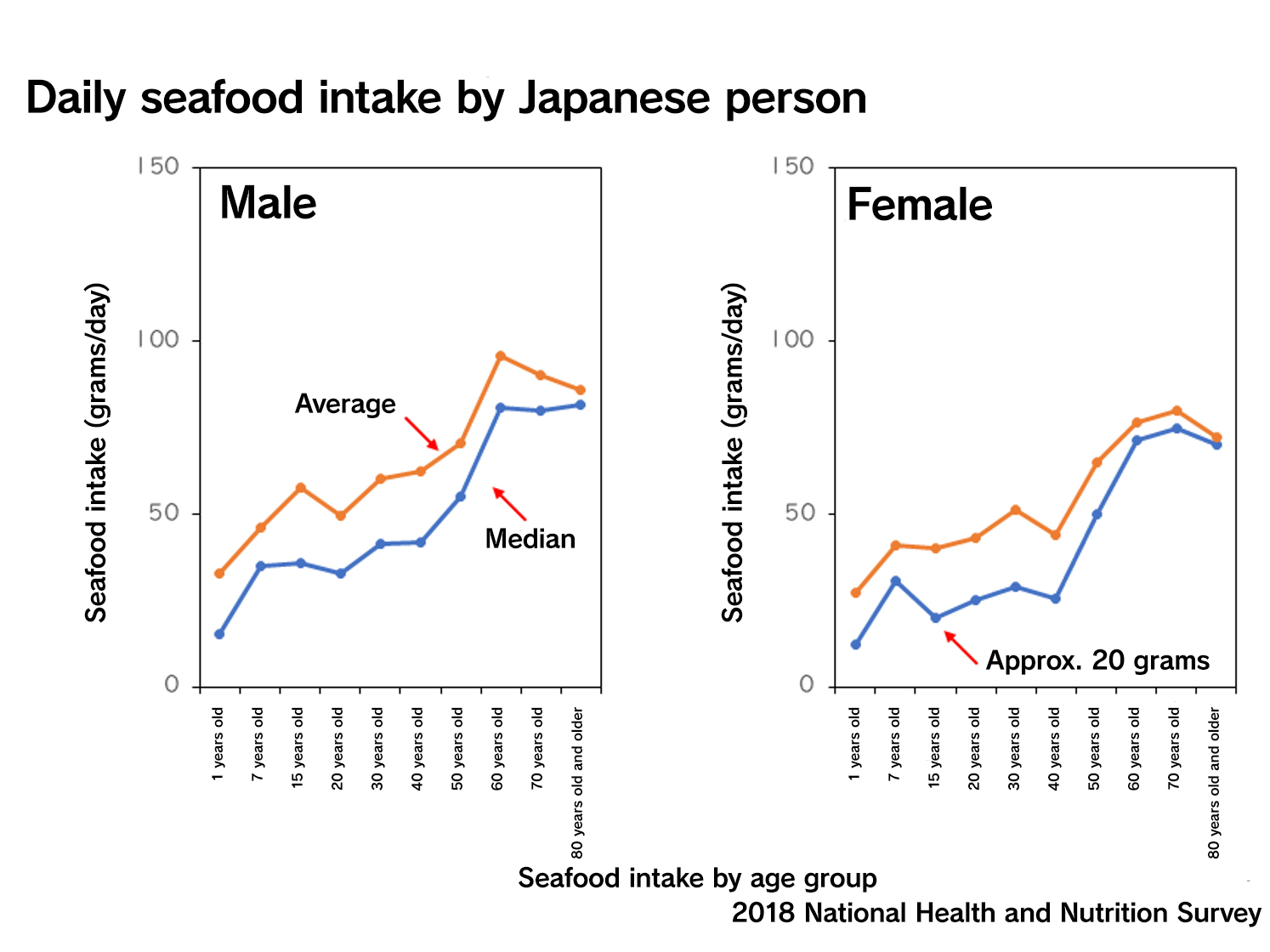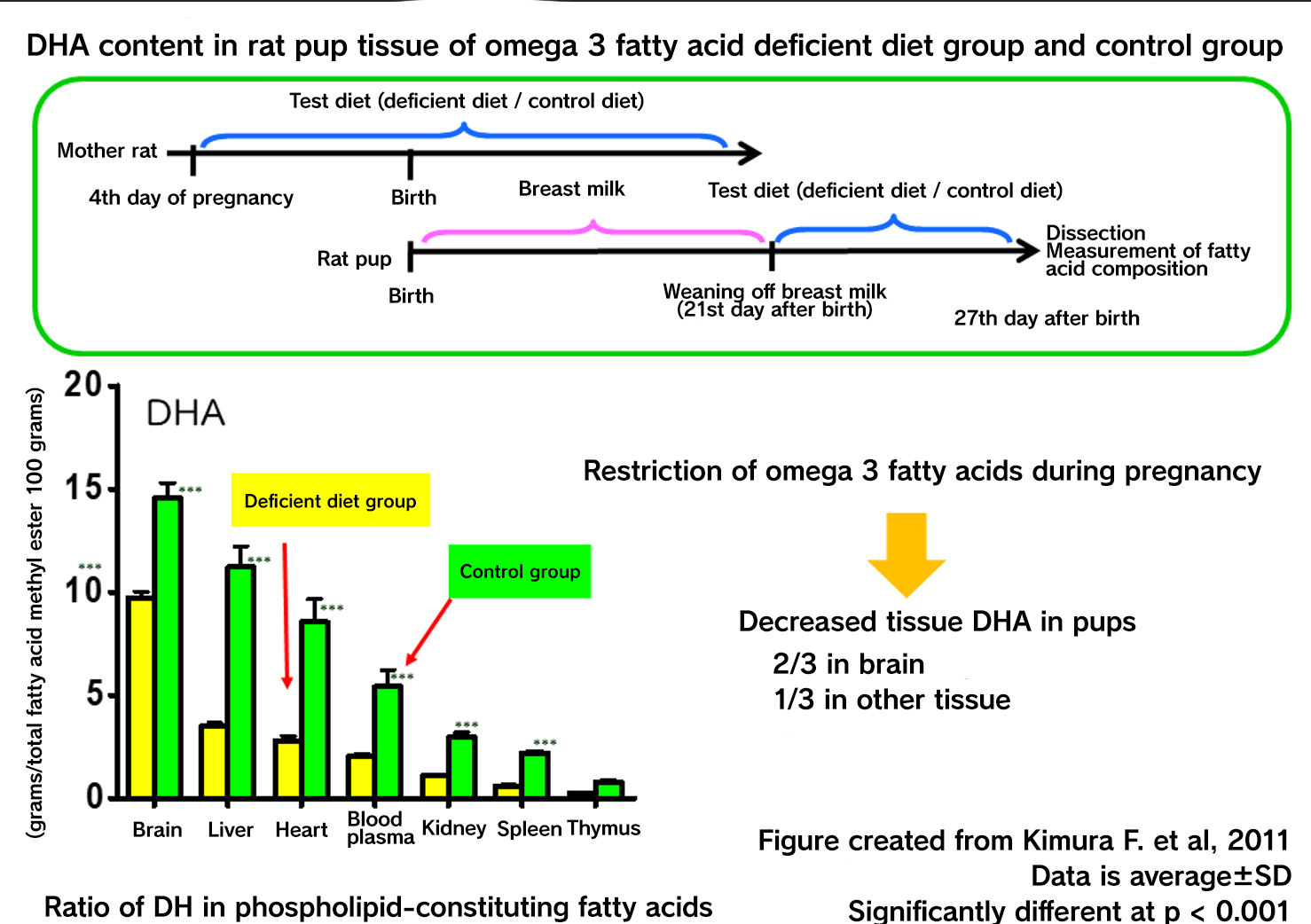

Similar to linoleic acid (18:2n-6), alpha-linolenic acid (18:3n-3) is an essential fatty acid which must be obtained through dietary intake. Perilla oil and linseed oil are well-known foods containing a large amount of alpha-linolenic acid. According to the composition table, alpha-linolenic acid accounts for 61.3% of all constituent fatty acids in perilla oil and 59.5% in linseed oil. Furthermore, alpha-linolenic acid accounts for 8.1% of canola oil (rapeseed oil) and 6.6% of soybean oil, both of which are commonly used in Japan. Accordingly, alpha-linolenic acid is thought to be obtained on a daily basis through a normal diet. Other foods rich in alpha-linolenic acid besides these oils and their raw materials are some foods such as chia seeds and walnuts, and are not nutrients that are widely distributed in various ingredients.

Alpha-linolenic acid undergoes metabolic conversion in vivo and is ultimately utilized as docosahexaenoic acid (DHA, 22:6n-3). DHA and its precursor eicosapenethanoic acid (EPA, 20:5n-3) are abundant in seafood. There is no clear evidence that α-linolenic acid, EPA, and DHA need to be considered separately as nutrients. Consequently, they are grouped together as omega 3 fatty acids in the Dietary Reference Intakes for Japanese. Until now, it has been said that a lack of omega 3 fatty acids is not a problem in Japan due to consumption of seafood, use of rapeseed oil and soybean oil for cooking, and frequent consumption of soybeans. In fact, when the amount of DHA contained in blood and breast milk is measured, it is higher in Japanese than in other countries where fish is infrequently consumed. In the fatty acid composition of the Japanese placental tissues measured by my research group, the composition ratio of DHA was higher than that reported in other countries where measurements were made under similar conditions. Due to this background and no symptoms of omega 3 fatty acid deficiency being observed in Japanese people, the recommended intake according to the Dietary Reference Intakes for Japanese people is set based on the current median omega 3 fatty acid intake of Japanese people.

However, due to recent social circumstances, the amount of seafood consumed by Japanese people is decreasing. According to the National Health and Nutrition Survey (previously known as the National Nutrition Survey), the average daily intake of seafood in Japan was estimated at 95 grams until around 2000, but in 2018 had decreased by 33% to 65.1 grams. Furthermore, when examining the details of the data, the median value of fish and shellfish intake is about half the average value. Also, unlike other food groups, the distribution is conspicuously skewed. Notably, the gap between the average value and the median value is large for young people under the age of 50, and the intake itself is low for that age group. As a result, the recommended amount of omega 3 fatty acid intake estimated from the median intake of the National Health and Nutrition Survey has been decreasing every year since 2005. In particular, in the case of pregnant women who are said to have a particularly high demand for omega 3 fatty acids, the recommended intake was 2.1 grams in 2005, but fell by approximately 25% to 1.6 grams in 2020. Against this background of decreasing intake of EPA and DHA derived from fish and shellfish, there is great interest toward alpha-linolenic acid as a source of omega 3 fatty acids. Therefore, I would like to reconsider the findings on DHA synthesis from alpha-linolenic acid.
DHA accounts for most of the omega 3 fatty acids existing in the human body. It is abundantly distributed in the cell membranes of the retina and cerebrum, and is essential for the normal functioning of the cerebral nervous system. Alpha-linolenic acid becomes DHA after being metabolized in vivo in animals. The essentiality of omega 3 fatty acids in humans was identified in the 1980s through reports of phenomena such as the development of neurological symptoms by a young girl who was being sustained by tube feeding with corn oil devoid of alpha-linolenic acid. Her symptoms were relieved by the administration of soybean oil. Subsequent research has indicated a particularly high requirement for DHA in fetuses and infants whose brains and nervous systems develop in a short period of time. Even in Western countries where there is no custom of eating fish, it is recommended to consume seafood during pregnancy and lactation. Why would DHA-rich seafood be recommended instead of oils containing alpha-linolenic acid? One basis for the recommendation is the indication that biosynthesis of DHA from alpha-linolenic acid is insufficient. For example, administration of DHA to humans has been reported to increase blood DHA, but administration of alpha-linolenic acid has not been observed to cause a significant increase in DHA (a metabolite) in blood. However, denying the usefulness of alpha-linolenic acid as a source of DHA is inconsistent with earlier studies reporting the essentiality of alpha-linolenic acid. In fact, in the case of women, an experiment using stable isotopes reported that 9% of ingested alpha-linolenic acid was converted to DHA. Research on humans is often limited to blood samples, and long-term dietary interventions that affect body composition are difficult to implement. Although the level of evidence is high, it should be considered that there are high barriers to estimating excess or deficiency of fatty acids from human intervention trials.

Although the research results cannot be directly extrapolated, the results of animal tests using rats, etc., are also useful in estimating changes in tissues. There is a paper that states that 6.0% of administered alpha-linolenic acid accumulated as DHA in rats. In animal studies by my research group, the phospholipid DHA in the rat pups of the alpha-linolenic acid-deficient diet group decreased to 66% in the brain and 33% in other tissues compared to the control group on the soybean oil diet. These reports indicate that, at least in rats, alpha-linolenic acid is used as a source of omega 3 fatty acids, although its metabolic efficiency is lower than that of DHA.
I am currently teaching food science at a registered dietitian training facility. At the time of admission, few of my students know about alpha-linolenic acid compared to the well-advertised DHA. Due to the curriculum, there is very little time to spend teaching about lipids. Currently, there is only one section explaining the structure of lipids, the necessary amount, the foods containing large amounts of lipids, and the fatty acids that are easily oxidized. I have heard from clinical nutritionists that although patients are very interested in fats, oils, and their health, it is difficult to get them to understand the specific characteristics of individual fats and oils. Alpha-linolenic acid is almost non-existent in living tissue and has no clear physiological function. Consequently, despite being common knowledge to specialized researchers, but it is difficult for the general public to grasp the role of alpha-linolenic acid. Therefore, I believe that it is important to continue to provide accurate information on a daily basis.
|